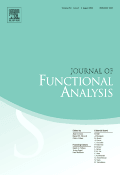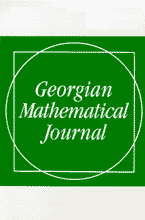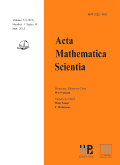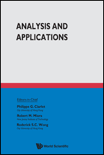
POTENTIAL ANALYSIS
Scope & Guideline
Elevating Understanding in Potential Theory
Introduction
Aims and Scopes
- Potential Theory and Analysis:
The journal emphasizes potential theory, which includes studies on harmonic functions, capacities, and associated operators. Research in this area often explores the mathematical foundations and applications of potential theory in various contexts. - Stochastic Processes and PDEs:
A significant portion of the journal's content deals with stochastic processes and their interactions with PDEs. This includes the analysis of stochastic differential equations (SDEs), large deviation principles, and their applications in mathematical physics and finance. - Nonlinear Analysis:
The journal showcases research on nonlinear phenomena, including nonlinear PDEs, variational methods, and inequalities. This encompasses studies on the existence, uniqueness, and regularity of solutions to complex mathematical models. - Geometric Analysis:
Research exploring geometric aspects of analysis, such as the study of manifolds, curvature, and geometric inequalities, is a core focus. This includes the examination of heat kernels, energy forms, and spectral theory in geometric contexts. - Functional Inequalities and Operator Theory:
The journal features contributions on functional inequalities, operator theory, and their applications in analysis. This includes the study of Sobolev spaces, Hardy spaces, and various inequalities that govern the behavior of functions and operators. - Harmonic Analysis:
Papers often delve into harmonic analysis, focusing on Fourier analysis, singular integrals, and their applications in various mathematical fields. This includes the study of function spaces and the properties of harmonic functions.
Trending and Emerging
- Stochastic Analysis and Applications:
There is a marked increase in papers addressing stochastic analysis, particularly concerning SDEs and their applications in various scientific fields. This trend reflects the growing interest in probabilistic methods and their implications for understanding complex systems. - Nonlocal and Fractional PDEs:
Recent publications show a significant focus on nonlocal and fractional PDEs, indicating a shift towards exploring generalized solutions and their properties. This emerging theme is crucial for addressing modern challenges in analysis and mathematical modeling. - Geometric and Functional Inequalities:
An upward trend in research on geometric inequalities and their functional counterparts has been noted. This includes studies on the interplay between geometry, analysis, and topology, which are increasingly relevant in contemporary mathematical discourse. - Higher-Dimensional and Metric Measure Spaces:
Research exploring higher-dimensional analysis and the properties of metric measure spaces is gaining traction. This trend highlights the importance of understanding geometry in the context of modern analysis and its applications to various mathematical fields. - Advanced Operator Theory:
The journal has seen an increase in contributions related to advanced operator theory, particularly concerning non-linear and multi-linear operators. This reflects a broader interest in understanding the complexities of operator behavior in various functional spaces.
Declining or Waning
- Classical Potential Theory:
Research that strictly adheres to classical potential theory has seen a decrease. While foundational studies remain relevant, there is a growing shift towards more complex and applied aspects of potential theory, particularly in stochastic contexts. - Basic Sobolev Spaces:
The exploration of traditional Sobolev spaces without considering more advanced or generalized forms has declined. Researchers are increasingly focusing on variable exponent Sobolev spaces and their applications, thereby overshadowing classical studies. - Elementary PDE Techniques:
The use of basic techniques in the analysis of PDEs has waned, as the field advances towards more sophisticated approaches that incorporate stochastic methods and complex geometrical considerations. - Single-Dimensional Analysis:
Research focused solely on one-dimensional problems has become less common, with a noticeable trend towards multi-dimensional analysis and its applications in higher-dimensional spaces.
Similar Journals

PUBLICATIONS OF THE RESEARCH INSTITUTE FOR MATHEMATICAL SCIENCES
Fostering Global Dialogue in Mathematical ResearchPublications of the Research Institute for Mathematical Sciences, ISSN: 0034-5318, E-ISSN: 1663-4926, is a distinguished academic journal published by the European Mathematical Society. Since its inception in 1969, this journal has emerged as a pivotal platform for disseminating high-quality research in the field of mathematics, achieving a notable position in the top quartile (Q1) of the Mathematics (miscellaneous) category as of 2023. With a current Scopus Rank of #121 out of 399, placing it within the 69th percentile for general mathematics, the journal serves as an essential resource for researchers, professionals, and students alike. It aims to foster the advancement of mathematical science through innovative research and comprehensive studies that encourage scholarly dialogue and collaboration. While access options may vary, the journal remains committed to enhancing the visibility and impact of mathematics research on a global scale. Based in Germany, at the Technische Universität Berlin, it continues to uphold a legacy of academic excellence and rigor in mathematical inquiry.

Analysis in Theory and Applications
Elevating Discourse in Theoretical and Applied SciencesAnalysis in Theory and Applications is a distinguished journal published by GLOBAL SCIENCE PRESS, focusing on the interdisciplinary fields of theoretical and applied analysis. Since its inception in 2004, this journal has aimed to advance knowledge through the dissemination of high-quality research articles, reviews, and technical notes that explore innovative methodologies and applications in analysis. Although the journal's coverage was discontinued in Scopus in 2011, it remains a valuable platform for researchers and practitioners looking to engage with emerging theories and practical applications in analysis. Researchers interested in contributing to the field can access various articles through traditional subscription options. The journal's commitment to rigorous peer-review and scholarly excellence makes it an essential resource for advancing the discourse in theoretical and applied sciences.

JOURNAL OF FUNCTIONAL ANALYSIS
Inspiring Collaboration in the World of Functional AnalysisThe JOURNAL OF FUNCTIONAL ANALYSIS, published by Academic Press Inc Elsevier Science, stands as a premier platform in the field of analysis, encompassing a broad spectrum of topics pertinent to functional analysis and its applications. With an impressive impact factor and categorized in Q1 for the year 2023, it ranks as one of the top journals in Mathematics (Analysis), placing it in the 77th percentile among its peers. This journal, founded in 1967, continues to provide researchers, professionals, and students with cutting-edge insights, rigorous publications, and a vibrant forum for scholarly discourse. The journal remains committed to advancing knowledge in the discipline and fostering an environment that encourages innovation and collaboration. Although it does not offer open access options, its high standards for publication ensure that each issue is replete with high-quality research that significantly contributes to the field. The journal's comprehensive coverage aligns well with the evolving landscape of functional analysis, making it an indispensable resource for anyone seeking to deepen their understanding and engage with current trends in this essential area of mathematics.

Georgian Mathematical Journal
Pioneering insights in diverse mathematical domains.Georgian Mathematical Journal, published by Walter de Gruyter GmbH, is a prestigious academic journal dedicated to the field of mathematics, particularly in its multifaceted applications and theoretical explorations. With an ISSN of 1072-947X and an E-ISSN of 1572-9176, this journal is indexed within notable databases and holds a strong position as evidenced by its Q2 ranking in the Mathematics (miscellaneous) category as of 2023 and a ranking of #140 out of 399 in the general mathematics Scopus category, placing it in the 65th percentile for research visibility. Since its inception in 1994, the journal has continued to evolve, aiming to foster innovative research and scholarly communication among mathematicians worldwide. Although it does not offer Open Access, the journal’s commitment to quality and rigor ensures that published works are of high relevance, appealing to researchers, educators, and students who are dedicated to advancing mathematical knowledge across diverse domains.

Dissertationes Mathematicae
Pioneering Insights in Mathematical Disciplines.Dissertationes Mathematicae is a prestigious academic journal published by the Polish Academy of Sciences Institute of Mathematics (IMPan), renowned for its contributions to the field of mathematics since its inception. With an impressive Q1 ranking in the miscellaneous mathematics category for 2023 and positioned at Rank #73 out of 399 in General Mathematics according to Scopus, this journal serves as a pivotal platform for disseminating high-quality research and innovative theoretical developments. Spanning from 2000 to 2024, it focuses on a broad range of mathematical disciplines, encouraging interdisciplinary collaboration and advancing mathematical understanding globally. While it currently does not offer open access, the journal is highly regarded in academic circles and continues to attract submissions from respected researchers and institutions. With a commitment to excellence and a notable impact factor, Dissertationes Mathematicae plays a crucial role in the ongoing development of mathematical theories and applications, making it an essential resource for researchers, professionals, and students alike.

ACTA MATHEMATICA SCIENTIA
Bridging Theoretical Insights and Applied InnovationsACTA MATHEMATICA SCIENTIA is a reputable academic journal published by Springer, primarily focusing on the interdisciplinary fields of mathematics and physics. With an ISSN of 0252-9602 and an E-ISSN of 1572-9087, the journal has established itself as an influential platform for researchers and professionals seeking to disseminate novel findings in these domains. Based in the Netherlands, the journal holds a commendable Q2 category ranking in both Mathematics and Physics & Astronomy for 2023, reflecting its significance in the academic community. With a focus extending from 1996 to 2024, ACTA MATHEMATICA SCIENTIA serves as a vital resource for scholars, offering insights that bridge theoretical and applied sciences. Published under rigorous peer review, the journal fosters a robust scholarly dialogue and encourages innovative research that challenges existing paradigms. While access is not open, the journal's contributions are of paramount importance for advancing knowledge in the mathematical sciences and their applications in physical contexts.

Advances in Operator Theory
Advancing Knowledge in Algebra and Number TheoryAdvances in Operator Theory is a premier journal dedicated to the exploration of innovative and foundational research within the disciplines of Algebra and Number Theory, as well as Analysis. Published by SPRINGER BASEL AG, this journal provides a vital platform for the dissemination of high-quality research and theoretical advancements in the realm of operator theory. With a commendable impact factor and categorized in the Q3 quartile for both Algebra and Number Theory and Analysis in 2023, it holds significant standing in the Scopus rankings, substantiating its relevance in the mathematical community. The journal encourages open discussions and lively exchange of ideas among researchers, professionals, and students alike, fostering an environment conducive to scholarly growth and collaboration. Based in Iran at PICASSOPLATZ 4, BASEL 4052, SWITZERLAND, it has been actively publishing since 2016, making substantial contributions to its field through rigorous peer-reviewed articles. As an essential resource for anyone invested in the forefront of mathematical research, Advances in Operator Theory continues to illuminate complex topics and inspire future inquiries.

COMMUNICATIONS ON PURE AND APPLIED ANALYSIS
Unveiling Insights in Pure and Applied AnalysisCOMMUNICATIONS ON PURE AND APPLIED ANALYSIS, published by the American Institute of Mathematical Sciences (AIMS), is a pivotal journal that serves the fields of pure and applied mathematics. With an ISSN of 1534-0392 and an E-ISSN of 1553-5258, this journal showcases rigorous research findings that span a myriad of topics within mathematical analysis and its applications. Given its impressive Q2 ranking in both Analysis and Applied Mathematics categories, it is recognized for its significant contributions, ranking 92nd out of 193 in Analysis and 369th out of 635 in Applied Mathematics according to Scopus. The journal, running continuously from 2004 to 2024, invites submissions that push the boundaries of mathematical thought and practice. While it operates under a traditional access model, the journal's comprehensive scope and burgeoning impact factor underscore its importance for researchers, professionals, and students who seek to engage deeply with current mathematical advancements.

Analysis Mathematica
Connecting scholars through rigorous analysis.Analysis Mathematica is a distinguished academic journal dedicated to the field of mathematics, focusing specifically on the varied aspects of analysis. Published by Springer International Publishing AG and based in Hungary, this journal has been an essential platform for scholarly communication since its inception in 1975. With a broad scope that encompasses theoretical developments and applications in mathematical analysis, it serves as a conduit for innovative research and discourse among mathematicians and researchers alike. While it currently holds a Q3 ranking in both Analysis and Miscellaneous Mathematics categories as of 2023, contributing authors are encouraged to elevate its impact through substantial contributions. Although not currently an open-access journal, Analysis Mathematica remains accessible through various academic databases, making it an invaluable resource for professionals, students, and researchers striving for excellence in mathematical analysis.

Analysis and Applications
Empowering Researchers with Cutting-edge Mathematical SolutionsAnalysis and Applications is a prestigious academic journal dedicated to the interdisciplinary exploration of analysis and applied mathematics. Published by WORLD SCIENTIFIC PUBL CO PTE LTD and based in Singapore, this journal serves as a vital resource for researchers, professionals, and students engaged in mathematical investigations that extend theoretical concepts into practical applications. With an impressive Impact Factor reflective of its esteemed reputation, it currently ranks in Q1 across both Analysis and Applied Mathematics categories, showcasing its relevance in advancing knowledge within these fields. The journal's commitment to high-quality scholarly articles is underlined by its excellent performance in Scopus rankings, placing it in the top percentiles of mathematics disciplines. Analysis and Applications invites contributions that not only deepen theoretical frameworks but also translate findings into applicable methodologies, ultimately fostering innovation and progress in mathematical sciences. For those seeking a gateway into cutting-edge research and developments, this journal is a crucial platform to engage with the latest insights and collaborative opportunities.